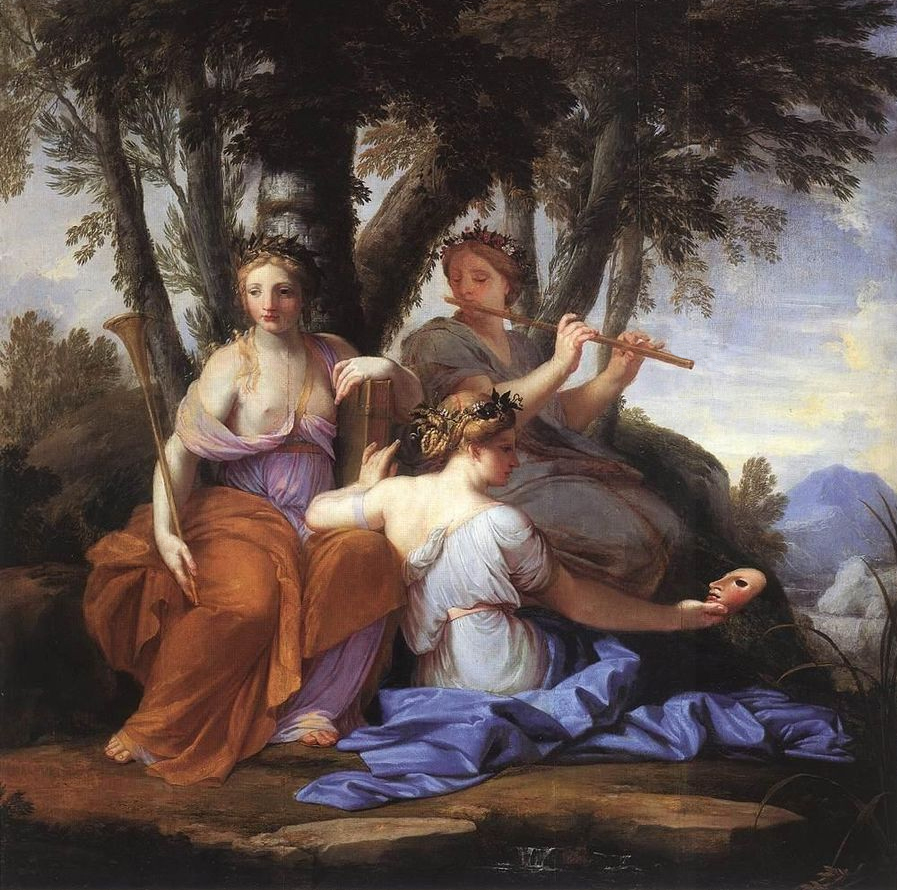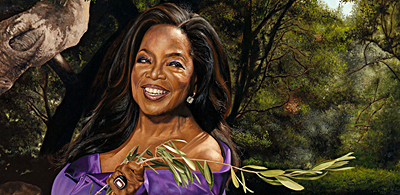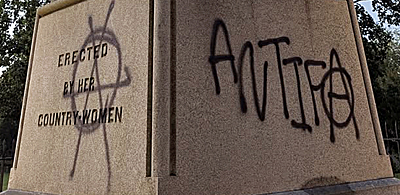Oprah Winfrey Portrait at the National Portrait Gallery
On Dec. 13, 2023, during a ceremony attended by throngs of media reporters, the National Portrait Gallery (NPG) in Washington, D.C. unveiled a nearly life-size oil painting of Oprah Winfrey. The painting was created by a 37-year-old Black artist from Chicago named Shawn Michael Warren.
The newest painting to grace the National Portrait Gallery was commissioned by the Smithsonian Institution, the NPG being a division of the Smithsonian. The choice of the personage portrayed in the artwork may surprise you, though my opinion of the painting most likely will not.
Reuters published a video report on the unveiling titled Oprah’s Smithsonian portrait to go alongside all the greats. Their headline was confusing, did “the greats” refer to those who sat for their portraits, or the artists who portrayed them? Either way the caption doesn’t apply to Winfrey or Warren… at least not in my opinion.

The director of the National Portrait Gallery, Kim Sajet (pronounced Say-et), issued a statement that Winfrey’s “contributions to popular culture and her philanthropy earned her a place at the museum.” She went on to say; “Through her rise to fame as host and producer of The Oprah Winfrey Show, Oprah demonstrated an unparalleled ability to connect with people and inspire them to become the best versions of themselves.”
Before the unveiling Lonnie G. Bunch, founding director of the National Museum of African American History and Culture, and the current Secretary of the Smithsonian, said to those gathered; “We the country are in your debt, Oprah.” How so Mr. Bunch? For starring in the 1985 Spielberg film The Color Purple? For endorsing Obama for president in 2006? For urging Mitt Romney to run against Orange Man Bad?
To a limited extent I can understand being a fan of Oprah Winfrey—but how does one come to the conclusion that America is in her debt?
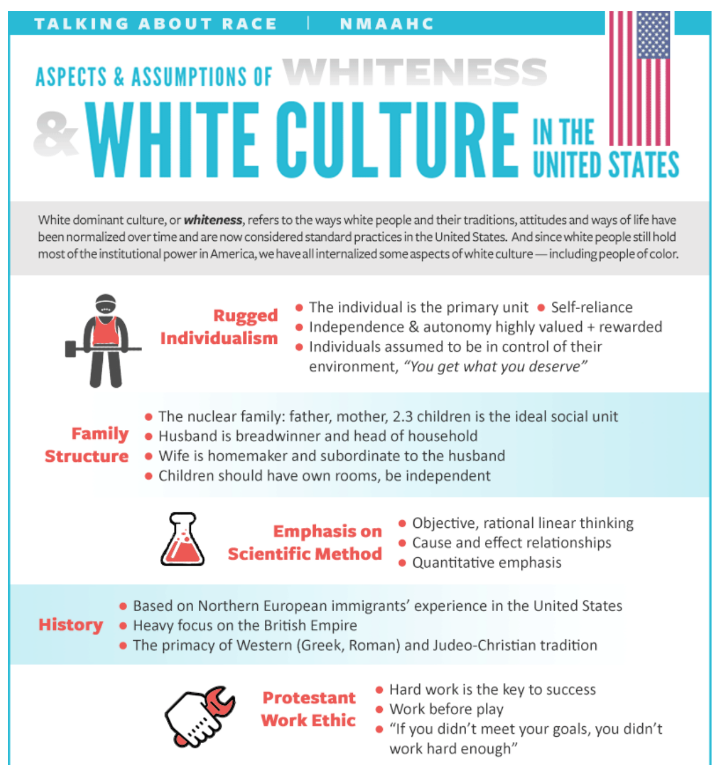
It should be remembered that in June of 2020, the National Museum of African American History and Culture launched Talking About Race, its “online teaching tool.” Bunch was Smithsonian Secretary at the time. The teaching tool’s webpage featured graphics that defined “hard work,” “self-reliance,” “respect for authority,” “objectivity,” the “nuclear family,” and more… to be attributes of “whiteness.” After considerable public backlash the Smithsonian removed the graphics.
The unveiling of Shawn Michael Warren’s Oprah is reminiscent of the hoopla over the portraits of President Obama and First Lady Michelle Obama that were unveiled at the Smithsonian’s National Portrait Gallery in 2018. Back then, director Kim Sajet said the swarms visiting that exhibit were “a form of secular pilgrimage.” The paintings of Barack and Michelle were painted by Kehinde Wiley and Amy Sherald, respectively.
In my Oct. 2, 2022 essay titled Picturing the Obamas and Kehinde Wiley, I exposed Wiley for using the Adobe Photoshop graphic art program to create the background of his Barack Obama portrait. Wiley used the Photoshop “Clone Stamp Tool” to digitally replicate the green foliage seen behind Obama; essentially rubber stamping the shrubbery… no drawing skills required. For this he’s rewarded by the National Portrait Gallery.
My essay also focused on Wiley running a studio in Beijing, China, where he uses low-wage Chinese “helpers” to paint his artworks. His popularity notwithstanding, I can’t help but see Kehinde Wiley as an absolute fraud.
In 2020 Shawn Michael Warren co-painted a Chicago mural with artists Jane Barthès, Anna Murphy, Kalan Strauss, and Janson Rapisarda (aka CERA). Titled Until We Meet Again, the street art mural featured a portrait of Oprah Winfrey painted by Warren. It inspired the Smithsonian to commission Warren to create an Oprah painting for the collection of the NPG. Barthès, Murphy, Strauss, and CERA were not included in the commission.
What do I think of Warren’s oil on linen portrait of Oprah now hanging at the NPG? It’s the best painting I’ve seen from him, which isn’t saying much considering so few of his paintings have been seen. However, my first impression was that it’s excessively dependent on photography; why not just display the photo he based the painting on?
I know it’s finicky of me but, the detail of an old fashioned street light in the upper left of the painting is so incongruous it drives me mad. It’s there for no reason, but once you see it the damn thing keeps demanding attention.
In fact, the Oprah painting somewhat reminds me of the works that came out of the American Photorealist Movement that began in the late 1960s and early 1970s.
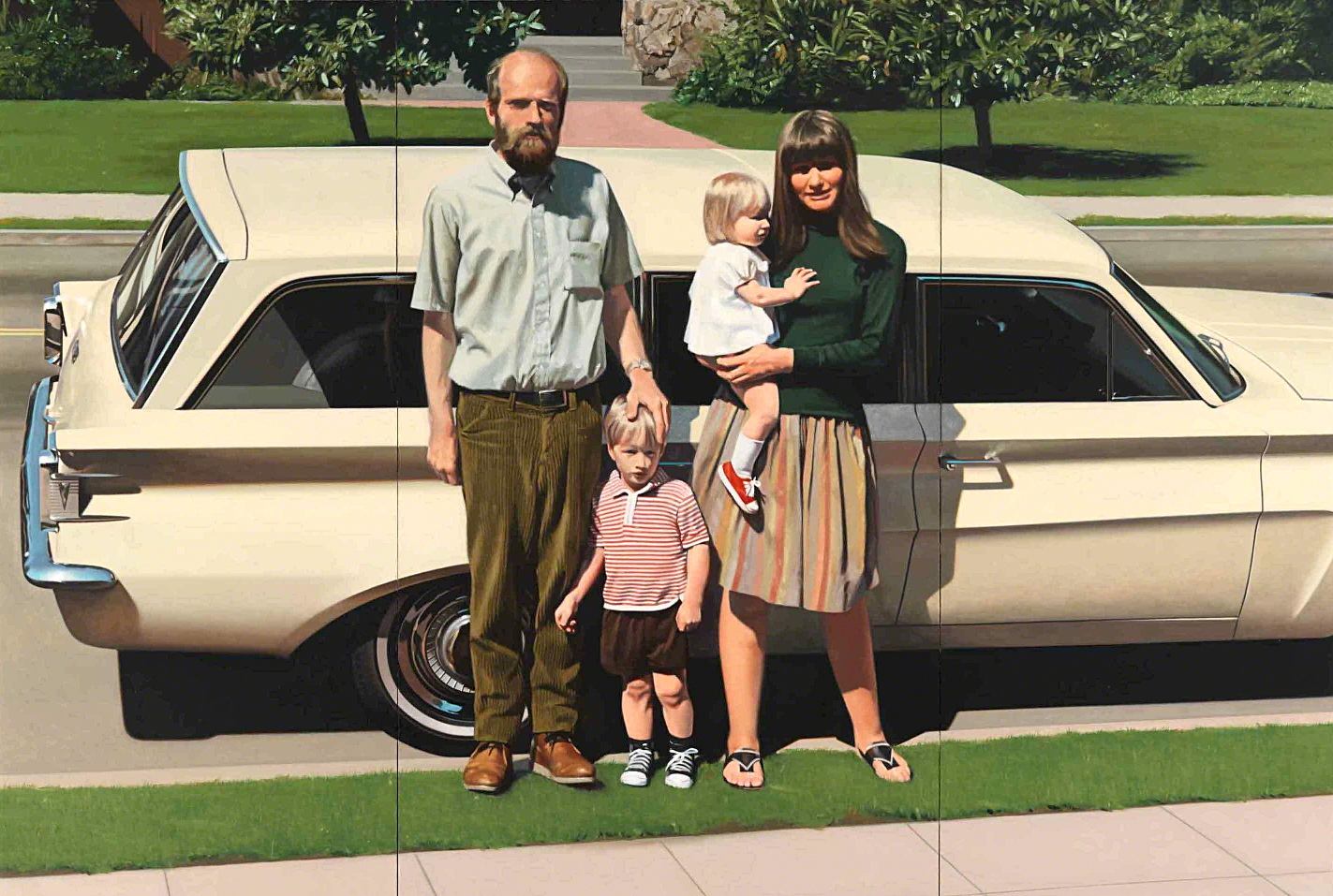
I once greatly admired the photorealists… when I was 18 in 1972. That’s when I discovered the works of Chuck Close, Richard Estes, Ralph Goings, Robert Bechtle, and others who worked obsessively to replicate photographs as oil or acrylic paintings.
As an aspiring young artist devoted to realism in art, I was intrigued with the works of the photorealists, but soon grew tired of their cold, precise style and moved on. At any rate, having evolved out of the American Pop Art Movement, the photorealists possessed a dry irony, while Warren only has title to a disproportional business sense.
Aside from rigidly copying photos, it appears to me Warren leans heavily on Adobe Photoshop, especially in creating his group portrait paintings. I suspect his group canvases like Abbot’s Waterway, In a Promised Land, and Troubled Waters, were composed in Photoshop as photomontages using unrelated photographs. That’s why symmetry and perspective in Warren’s multiple figure works is oddly skewed… the pieces don’t fit.
This is especially so with Warren’s inept and amateurish The Siege of Granada: January 2, 1492, which I’ll get to later in this essay.
Nowadays Adobe Photoshop includes a component of Artificial Intelligence (AI), which leads to a much bigger question. Will contemporary artists stop using a centuries old visual language based on human skill, emotion, and observation—and exchange it for the machine language of computers?
This has already occurred in many spheres; think of how the human hand has been replaced by software in animation and movie special effects. Will this be the fate of high culture as well?
Don’t misunderstand. I’m all for innovation and new tools, but not at the expense of trashing time-honored, and traditional methods of creating art.
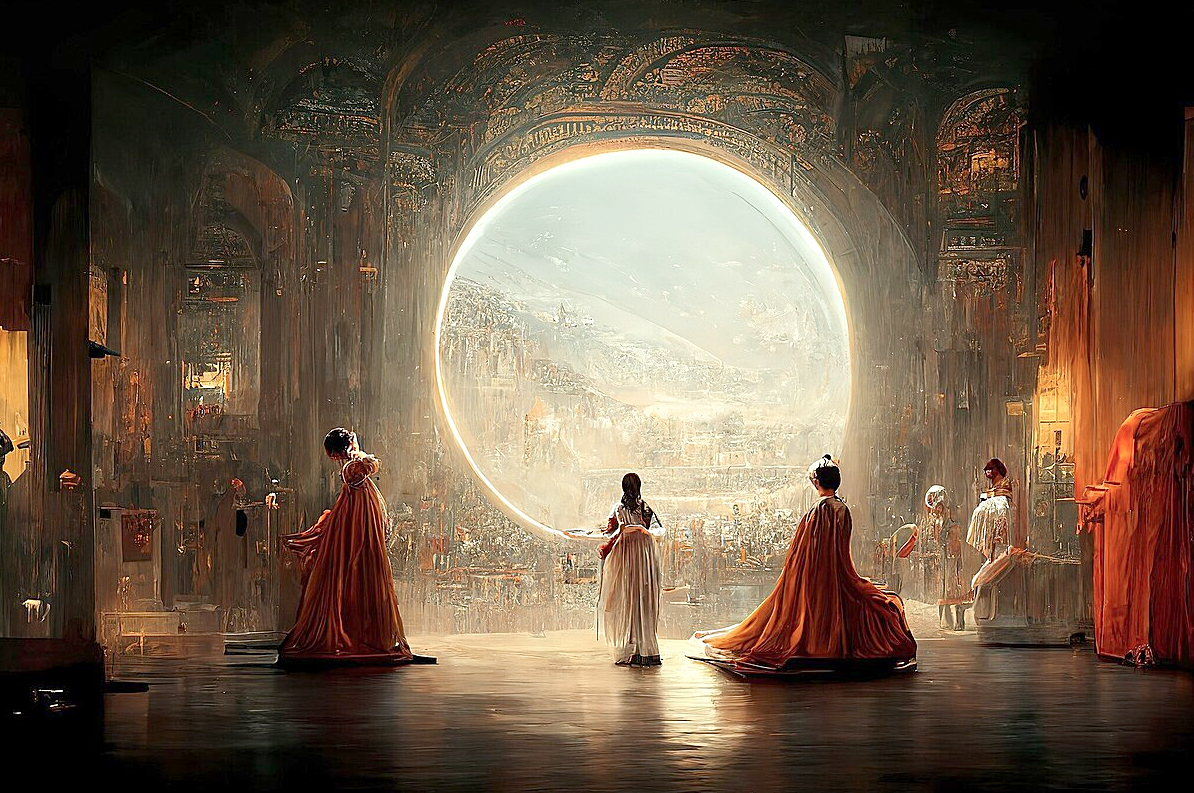
Currently, many people are unable to tell the difference between art made by hand or synthesized by Artificial Intelligence. In a Sept. 2022 fine arts competition in Colorado, a “painting” titled Théâtre d’Opéra Spatial (Space Opera Theater) was awarded a prize by judges who were unaware the image was created by the MidJourney AI art generator. This is a hazardous and self-destructive path for artists to take.
How does Artificial Intelligence impact the art of Shawn Michael Warren?
The IT services and consulting company FlexTech.ai, describes its work on its website as generating the “development of new tech, go-to-market brand building” and facilitating “non-profit creation.” The firm touts itself for using “artificial intelligence with human intelligence” to allow clients to “optimize processes.” The company also boasts helping clients “extend their brand presence, offering, and creativity.”
Incidentally, FlexTech.ai refers to Shawn Michael Warren as “our client,” and states it is “also thrilled” with having created his personal website. What exactly is going on here?
In 2023 FlexTech.ai commissioned a painting from Warren, he titled it La Reina Calafia (The Queen Calafia). It was loaned to the US Embassy in Madrid then placed on the Biden State Department’s Art in Embassies website. That’s quite an example of “go-to-market brand building,” but in my understanding of the painter’s craft this is troubling. I recall a line from the Mel Brooks Spaceballs parody… “Merchandising! Merchandising!” The US Department of State Art in the Embassies website describes Shawn Michael Warren in this way:
“His emphasis on narrative, historical subjects is a central feature of his larger viewpoint, which looks at the History of the United States, and the world, via the experiences of BIPOC [Black, Indigenous, and People of Color] to communicated essential human truths, and initiate uncomfortable conversations surrounding race, sociopolitical subjects, and culture.”
As for Warren’s Reina Calafia, allow me to initiate an uncomfortable conversation. She actually was a character in Las sergas de Esplandián (The Adventures of Esplandián) a chivalric romance novel written by Spanish author Garci Rodríguez de Montalvo sometime around 1510. Calafia was Queen to a race of pagan Black Amazons that lived on an island they called “California.” The author modeled the name “Calafia” from “Califa,” Spanish for khalifa (an Islamic state leader).
In Montalvo’s novel, an army of women led by Calafia, went to help Muslims overthrow the Christian kingdom established in the city of Constantinople. Instead Queen Calafia met defeat, surrendered, and converted to Christianity. She married a Christian Knight and returned to California to rule over men and women in a Christian monarchy.
Warren no doubt painted Reina Calafia as a strong BIPOC leader, but he had to utterly ignore the novel by Garci Rodríguez de Montalvo to do so. Montalvo had just seen Spain freed from Islamic rule when he wrote his book, and he meant his tale of Reina Calafia as an indictment against paganists and those who would undermine Christendom.
Hernán Cortés had read Montalvo’s fable of Reina Calafia, and there’s little doubt that Cortés and his Conquistadors were thinking of the story when they subjugated the mighty Aztec Empire. So much for Shawn Michael Warren communicating “essential human truths.”
While Warren’s portrait of Oprah is suddenly found all over the internet, other examples of his art are not so easy to find, especially older works. His personal website displays only 15 paintings and drawings, and all are fairly recent. When conducting a thorough online search for Warren’s art, I found his aforementioned painting, The Siege of Granada: January 2, 1492.
The title of Warren’s painting refers to the monumental 1492 battle European Christians waged against the Islamic occupying armies that had conquered and colonized Spain. You could also say it was a heroic war waged by Muslims to protect the Umayyad Caliphate they had established in Spain; it all depends on where your sympathies lie. But what are Warren’s allegiances?
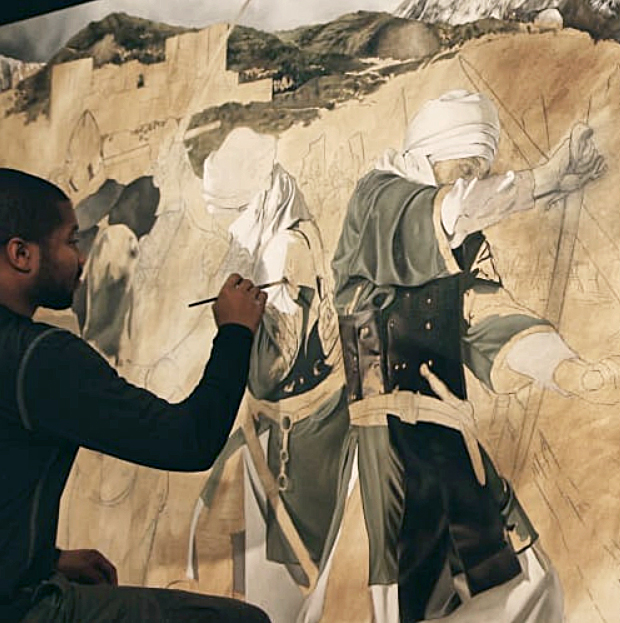
The Islamic invasion and conquest of Spain occurred between 632 and 732, leading to 780 years of Islamic rule. The Muslims referred to Portugal and Spain as “al-Andalus,” and annexed the land into their Caliphate.
The Emirate of Granada was established in 1238, and eventually Christian armies from all over Europe gathered to expel the Muslim colonists in a movement known as the Reconquista (Reconquest).
In 1492 the armies of King Ferdinand and Queen Isabella (the Royals who sent Christopher Columbus on his fateful mission that same year), put the Islamic armies under siege at the city of Granada. The Islamists surrendered to the Christians on Jan. 2, 1492, forever ending Muslim rule over Spain.
The question is, what does Shawn Michael Warren actually think about the Muslims conquering Spain, and the Europeans liberating their lands from the Islamic Caliphate. Why did Warren create a painting on the subject? You will not find the answer anywhere online, not even on the artist’s official website, where the painting isn’t even mentioned.
Online info regarding Warren’s The Siege of Granada: January 2, 1492 is scant. The Detroit Hometown Life website published a photo essay on the city’s ArtPrize contest of 2016—a competition for wishful artists. Warren’s The Siege of Granada: January 2, 1492 was the 24th entry on the page. Only the title and artist’s name was given. The article’s publication date gave the likely year of the painting’s creation, 2016.
Then I found my one and only clue concerning Warren’s reason for painting The Siege of Granada: January 2, 1492.
I discovered it on the SDVoyager website, which published a 2019 interview with Warren where he said he had “completed a 10-painting series for the Abrahamic Center for Cultural Education in Chicago.” Noting that the narratives for his artworks were “from the Quran,” he added that “the paintings are permanently installed in the Center’s gallery.”
If you visit the website of the Abrahamic Center for Cultural Education (ACCE), you will find Warren’s series of Qur’anic paintings in the center’s Virtual Tours section. Trust me… they’re nothing to write home about.
While Warren’s The Siege of Granada: January 2, 1492 is not displayed on the Abrahamic Center for Cultural Education website, his collaboration with the Center in illustrating Qur’anic verses gives some insight into what he feels about the actual Siege of Granada and why he painted the theme.
It’s interesting that Warren did not include The Siege of Granada: January 2, 1492 on his personal website, which also does not mention his creating paintings for the Abrahamic Center. One might think Warren would be proud of these artworks, and would want to share them with the public.
It’s almost as if Warren, or his benefactors, scrubbed The Siege of Granada: January 2, 1492 from the internet, along with making an attempt to conceal his partnership with the Abrahamic Center. Was this done in order to tidy-up his art “credentials” and extend his “brand presence”? Excuse me while I adjust my tinfoil hat.
On Oct. 19, 2023 the Abrahamic Center for Cultural Education published an official statement regarding their position on the war between Gaza and Israel. In the document the ACCE said they opposed; “the war crimes and the unlawful occupation endured by the Palestinian people, inflicted upon them by the State of Israel.” The ACCE avowed; “We acknowledge that this genocide is a byproduct of a colonial settler state, and this cycle of violence will persist as long as people remain under occupation.”
The Abrahamic Center for Cultural Education forgot to mention that on Oct. 7, 2023, 3000 Hamas gunmen crossed into Israel from Gaza and murdered 1,139 people, most of them civilians.
Hamas terrorists dragged 248 innocent hostages back into Gaza—women, grandparents, the disabled; among them were 33 children and a 9-month old baby. Some of the Israelis killed or kidnapped that day were peace activists who worked with Palestinians. During the bloodbath, from inside Gaza, Hamas launched 1000s of missiles at Israeli civilian targets.
Freedom fighters don’t kidnap children and massacre seniors, but bloodthirsty gangsters do.
I wonder what Oprah Winfrey, the Smithsonian, and the National Portrait Gallery think of the atrocities committed by Hamas. Does Shawn Michael Warren still get that warm fuzzy feeling for having cooperated with the ACCE, or does he hope people never discover the partnership?
But lets get back to The Siege of Granada: January 2, 1492. Considering Warren’s well-disposed interactions with the Abrahamic Center, and the disdain Muslims generally have for the Christian Crusaders of old, does Warren’s painting celebrate the white Europeans who fought to liberate their land, or does it extol the Muslims who battled to keep them enslaved to the Islamic caliphate. Go ahead, take a wild guess.

Honestly speaking, as a painting The Siege of Granada: January 2, 1492 reveals the poverty of Warren’s artistic vision. The figures pictured in combat are contrived and awkward. It’s a lifeless, hackneyed painting that is dreadful on every level. By hiding the amateurish thing Warren’s body of work is instantly improved. For goodness sake, I’ve seen better artwork used in the Chivalry II Medieval Warfare video game.
To further make my point, compare Warren’s The Siege of Granada: January 2, 1492, to the illustrious oil painting titled La rendición de Granada (The Surrender of Granada), created in 1882 by the Spanish painter Francisco Pradilla Ortiz (1848-1921). It shares the same theme Warren attempted to explore… but the comparison stops there.
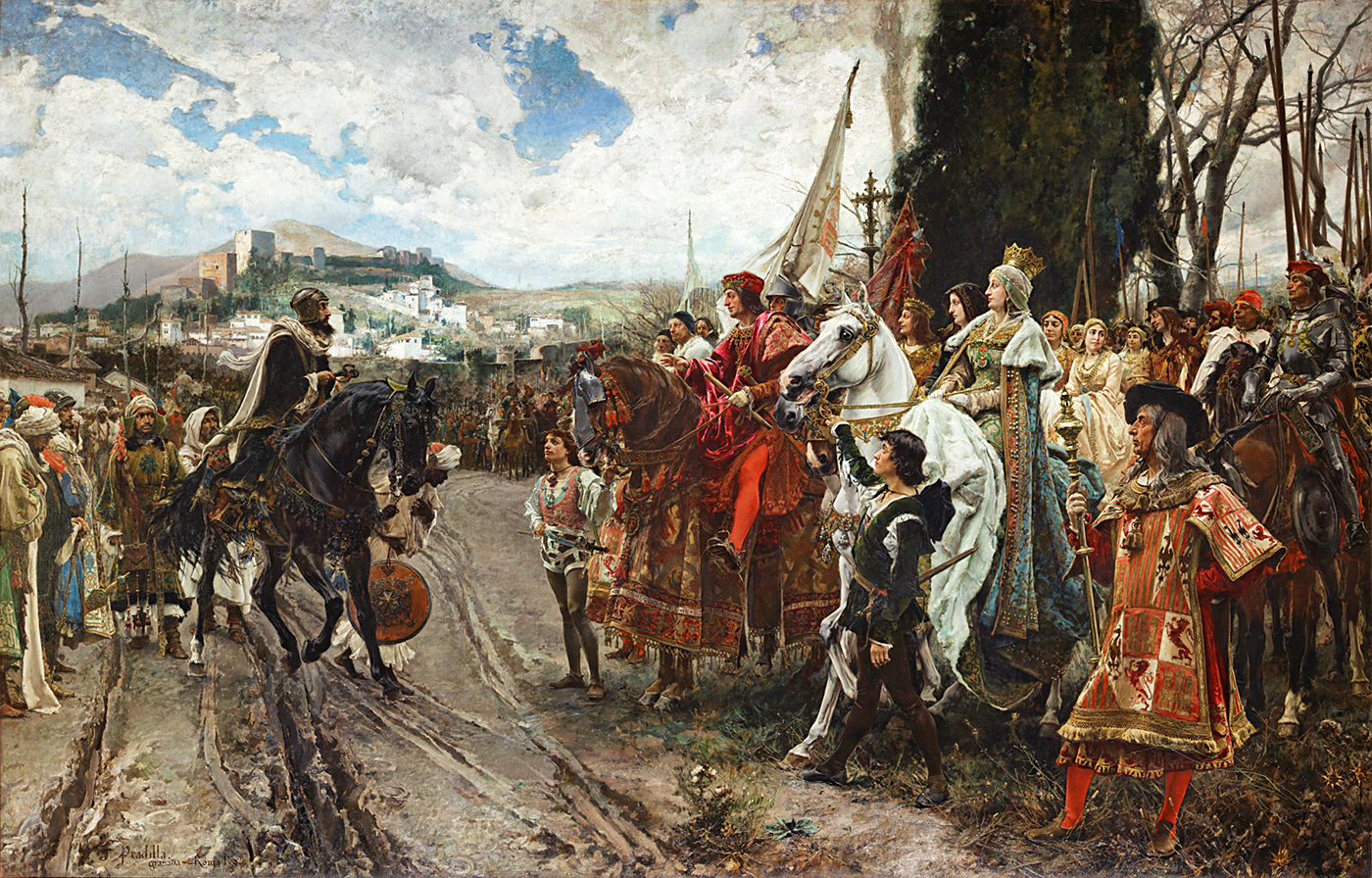
Ortiz captured the moment when the last Muslim ruler of al-Andalus, Abu Abdallah Muhammad XII, surrendered to the King and Queen of Spain.
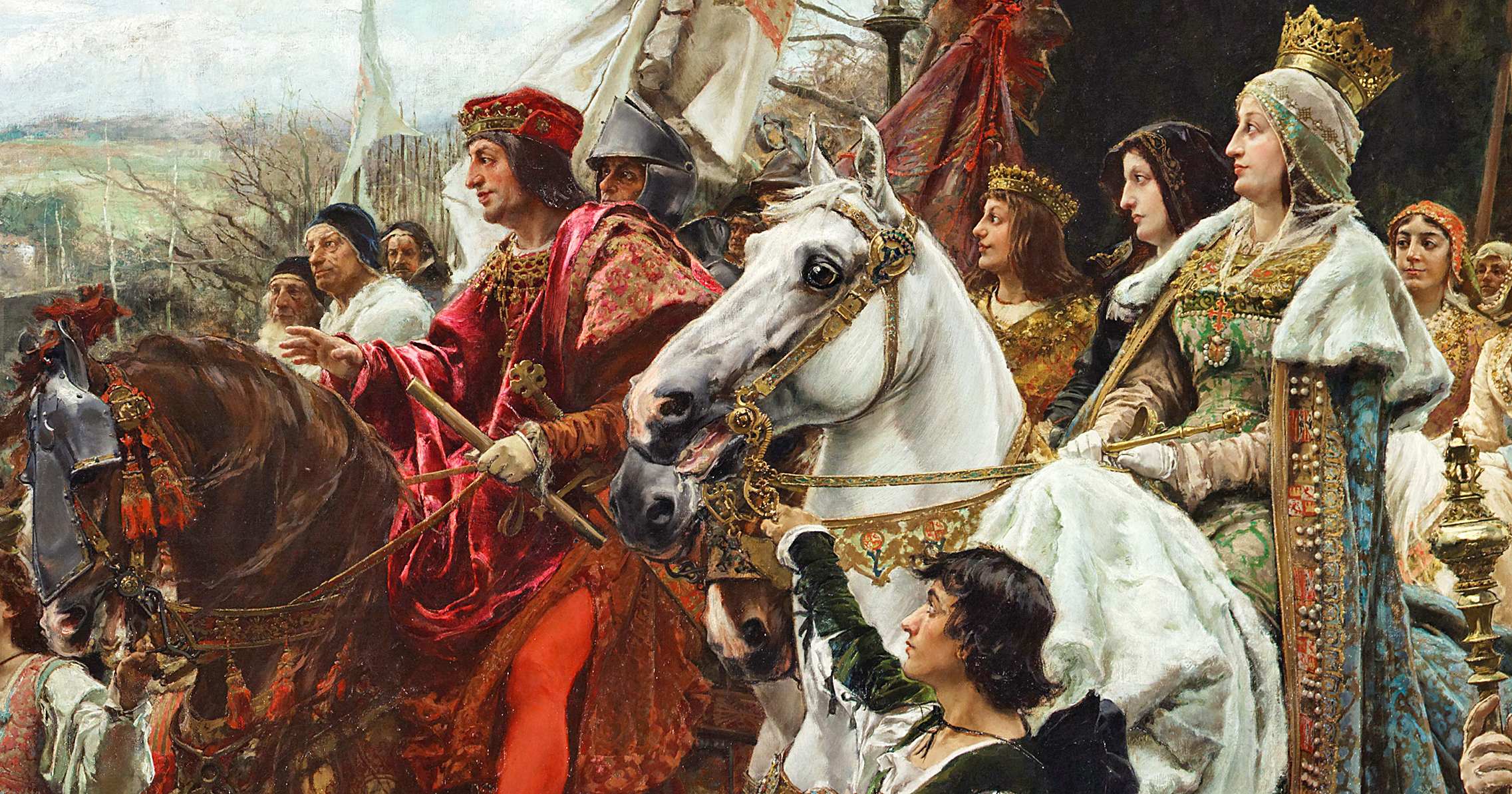
The realism of the painting is breathtaking, the composition and technique are beyond reproach. The painting draws the viewer in to examine the entire tableau, from the mud in the foreground to the splendid city perched on the hills delineated in the background.
Ready to capitulate to the Spanish King and Queen, Muhammad XII is depicted by Ortiz as sitting astride a black warhorse, but it’s the pious looking turbaned warrior holding the stead’s reins that draws my attention.
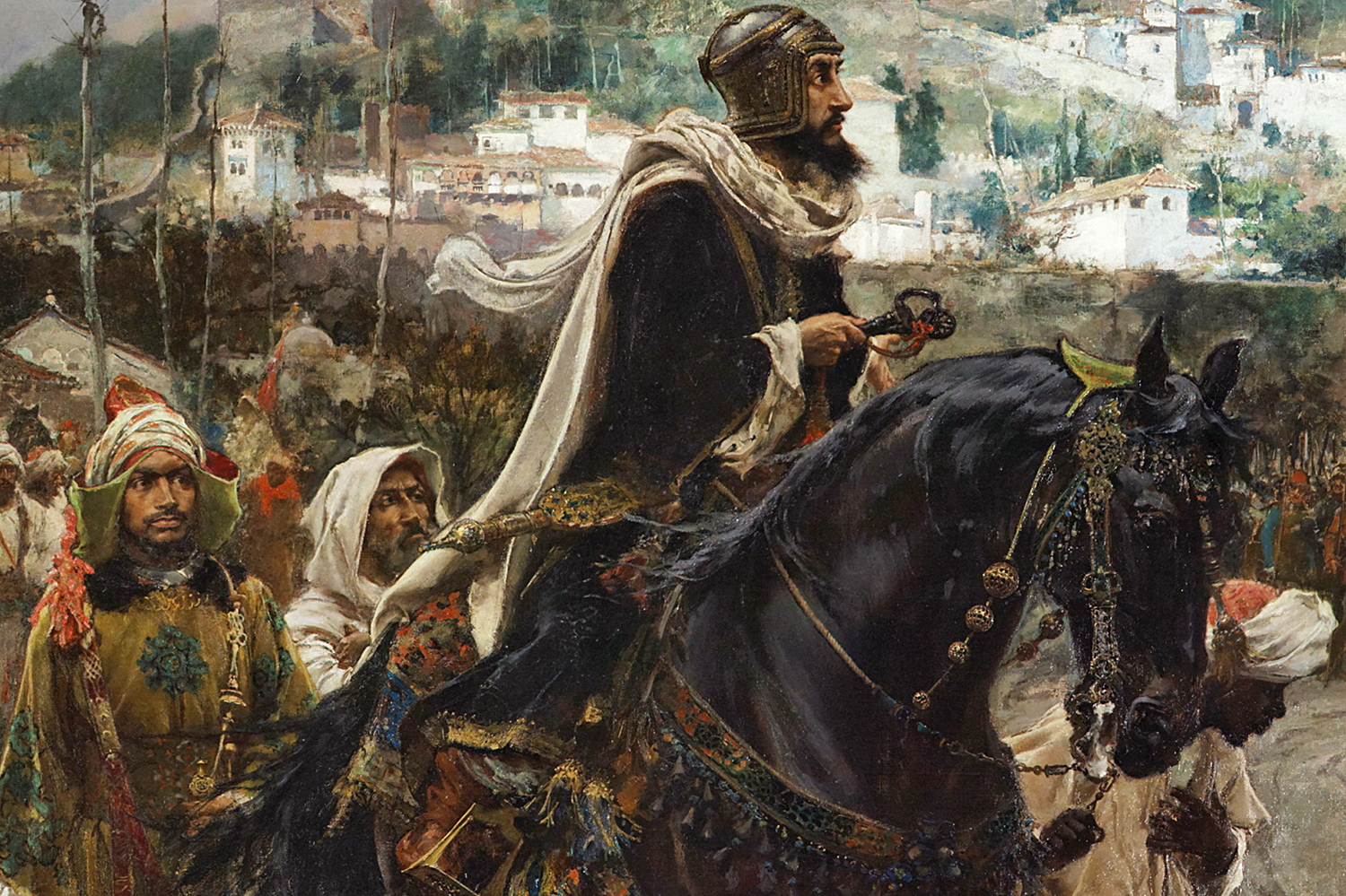
For me he’s a pivotal detail in the painting. With a few adroit brushstrokes, Ortiz painted the profile of a young man standing barefoot in the mud. He epitomizes all those who fought the bloody conflict. A large sheathed knife is tucked in his belt, from which his shield dangles. The war is over and he accepts defeat. His hand rests on his heart and he bows slightly towards the Spanish King and Queen, suggesting acquiescence.
Staring incredulously at King Ferdinand and Queen Isabella, the shocked look on the face of Muhammad XII reveals his disbelief that he’s giving up to infidels. The black horse he rides is wide-eyed and froths at the mouth.
With nuanced portraits, multitudinous textures, lavish garments and weapons of war, all detailed with skill and precision, the Ortiz canvas mesmerizes. As a Spaniard, Ortiz likely felt the defeated Muslims in his painting were despotic overlords, yet he painted them sympathetically as stoic men who lost a war and their empire.
It’s a shame that artists like Francisco Pradilla Ortiz are today nearly impossible to find; contemporary art schools certainly don’t produce them. The moderns have replaced them with the likes of Shawn Michael Warren and Kehinde Wiley, twiddlers who are endlessly praised and given a place of honor in the National Portrait Gallery.
Once upon a time the National Portrait Gallery collected and displayed portrait oil paintings and photographs that represented a Pantheon of extraordinary Americans. I once walked through the galleries of the NPG. I discovered in its hallowed halls images produced by superlative artists that depicted high-minded heroic figures like George Washington, Thomas Jefferson, Alexander Hamilton, Sequoyah, Abraham Lincoln, Harriet Tubman, and Frederick Douglass.
Just imagine, the immortals Abraham Lincoln and Frederick Douglass sharing their place in history with talk show host and billionaire media mogul Oprah Winfrey. What a mockery. Instead, Winfrey’s portrait by Shawn Michael Warren would be better placed on the cover of People Magazine.
I once assumed that inclusion in the National Portrait Gallery was based purely on an artist’s merit. If an artist possessed praiseworthy talent, distinctive skills, superlative artistic vision, and their works gave value to our nation’s history and culture… their works would be admitted into the constellation of greats. I no longer believe that.
Not long ago Americans visited museums to find beauty, ecstasy, and profundity in art. Sadly, based on the recent history of the National Portrait Gallery, it appears that is no longer the case.
It can be argued that today the three Muses, those inspirational goddesses of science, literature, and art, have abandoned us. Our worship of what’s tasteless, pretentious, and kitsch, especially our fetishization of celebrity… has driven them away.
